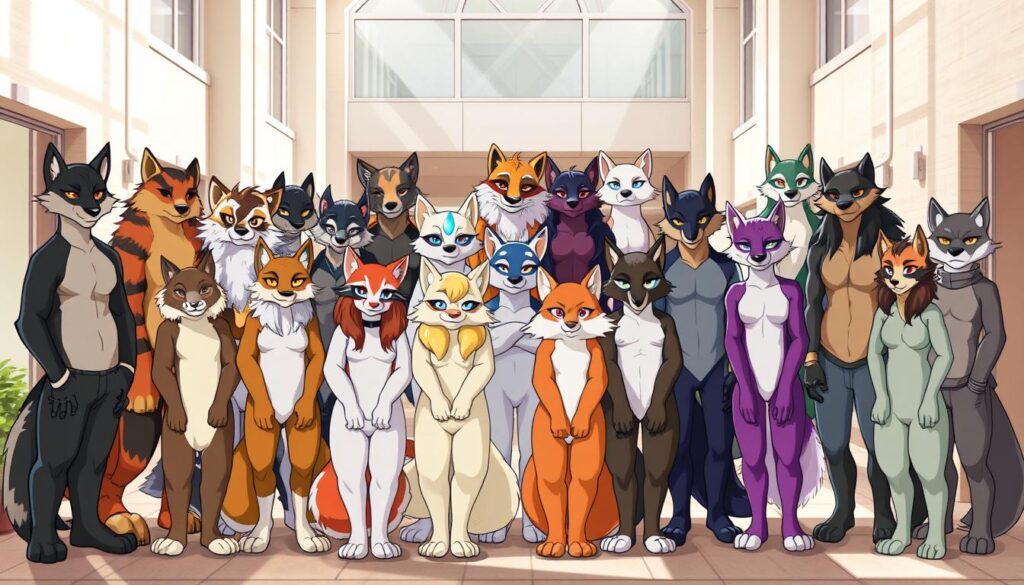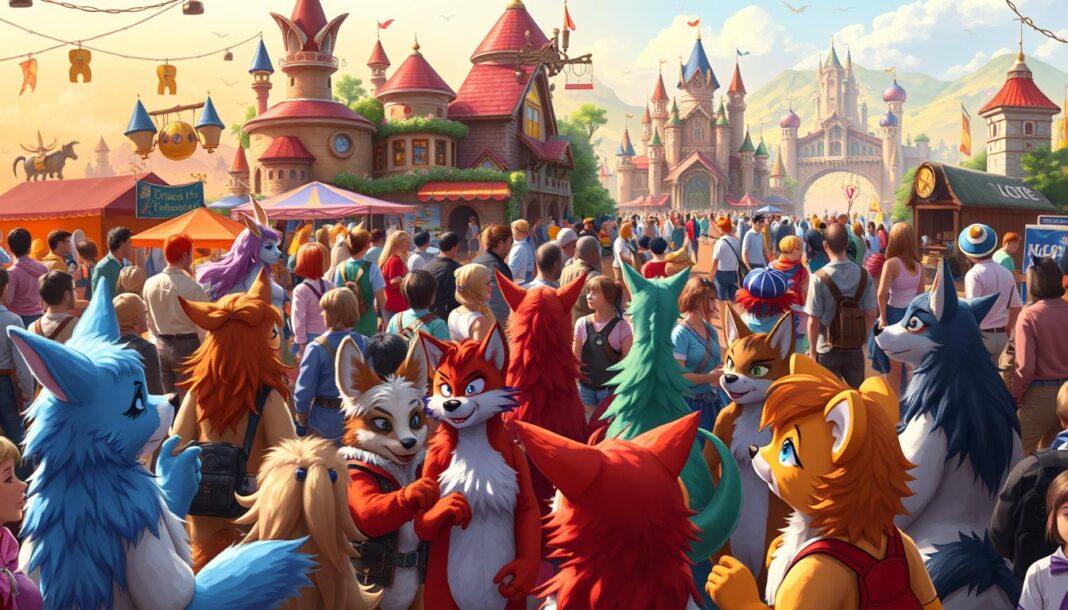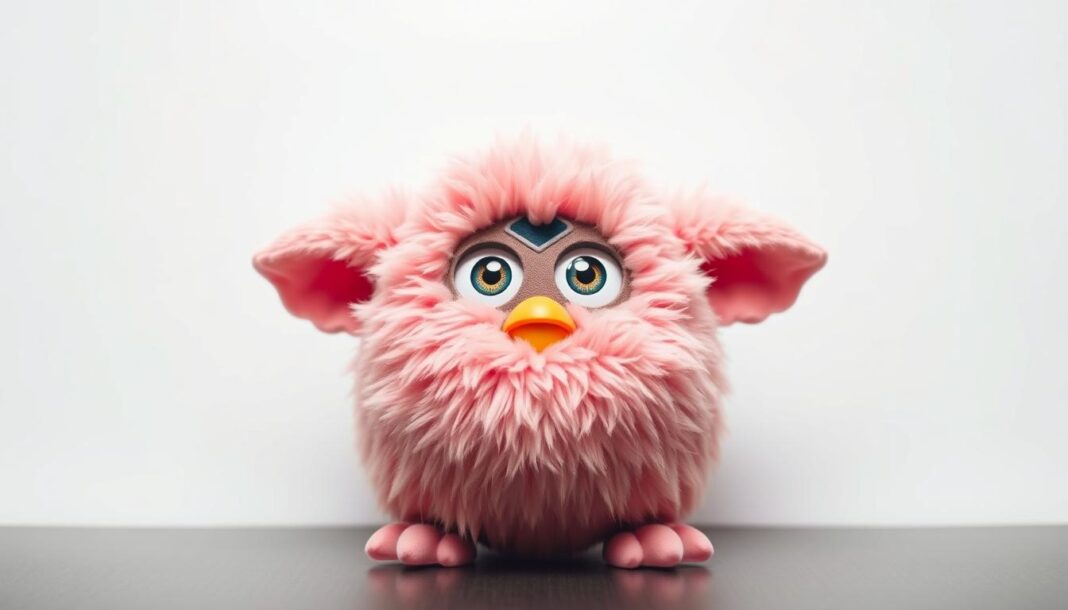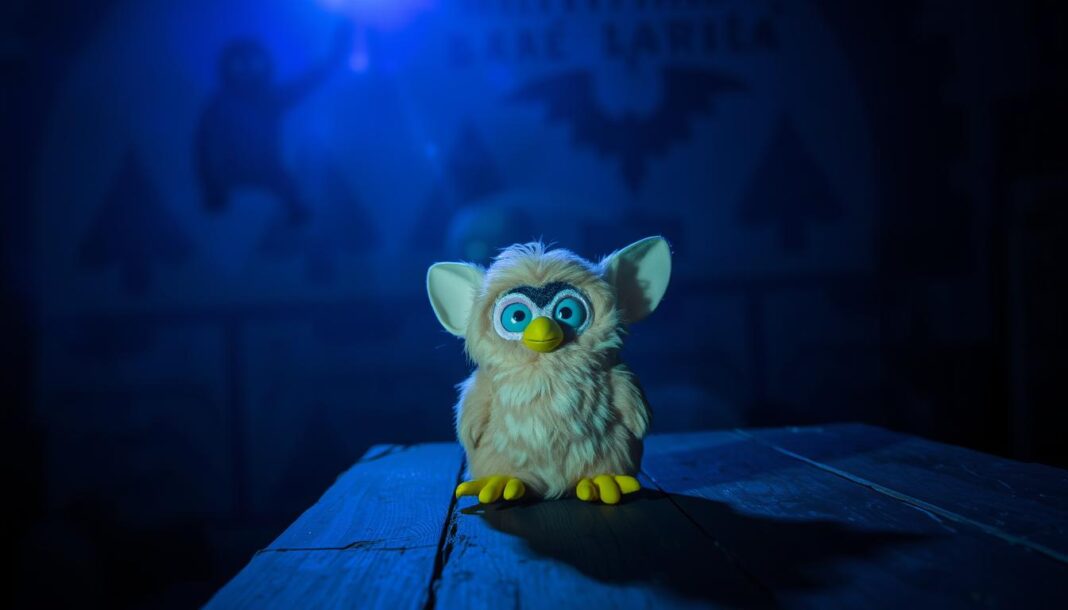The world of furries is a fascinating and often misunderstood subculture. At its core, the furry fandom is a community of people who enjoy characters and stories featuring anthropomorphic animals.
As we explore this vibrant fandom, we’ll reveal surprising statistics about its global population and examine the challenges of accurately counting furries due to the community‘s diverse nature.
By delving into various research methods, including surveys and online community membership, we’ll gain insight into the number of people involved in this phenomenon and how it’s grown into a worldwide sensation.
Understanding the Furry Fandom
To understand the furry fandom, we must first explore its roots and the factors that define it. The furry community is a diverse group of individuals united by their interest in anthropomorphic animals, which are animals given human characteristics. This shared interest has evolved into a distinct culture with its own art, literature, and social norms.
What Defines a Furry?
A furry is typically defined as someone who is interested in anthropomorphic animals. This interest can manifest in various ways, including through art, fiction, and even the creation of a personal identity or “fursona.” The furry fandom is characterized by its creativity and the diverse ways in which its members express themselves. For many, being a furry is about exploring identity and creativity through the lens of anthropomorphic characters.
Origins and Evolution of the Fandom
The concept of furry originated in the early 1980s at science fiction conventions, where discussions about anthropomorphic characters in science fiction and comics led to the formation of a dedicated group. According to fandom historian Fred Patten, a drawing from Steve Gallacci’s Albedo Anthropomorphics sparked a discussion that eventually led to the establishment of the furry fandom. Over the years, this community grew from small gatherings at conventions into a global community with various groups and online platforms. The term “furry fandom” became standard by the mid-1990s, reflecting the growing recognition of this unique cultural phenomenon.
The evolution of the furry fandom has been marked by its adaptation to new technologies and social trends. The rise of the internet played a crucial role in connecting members of the community worldwide, facilitating the sharing of art and other creative works. Today, the furry fandom is a vibrant and diverse community that continues to grow and evolve.
How Many Furries Are There in the World?
As the furry fandom continues to grow, so does the interest in understanding its demographics, starting with a fundamental question: how many furries are there? The furry community is a vibrant and diverse group, making it challenging to estimate its size accurately.
Challenges in Counting the Furry Population
Counting the furry population is not straightforward due to the community’s nature. Many furries participate online, where anonymity is common, making it difficult to track membership or participation accurately. Moreover, the community is global, spanning across different countries and cultures, which adds to the complexity of data collection.
Key challenges include:
- Defining who qualifies as a “furry”
- Accessing reliable data from online platforms
- Accounting for regional variations in community engagement
Despite these challenges, researchers have made significant efforts to estimate the size of the furry community through various methodologies.
Current Estimates and Research Findings
Several surveys and studies have attempted to estimate the size of the furry community. One notable source is FurScience, a research group that has conducted extensive surveys of the fandom. According to their data, the furry population is estimated to be in the hundreds of thousands worldwide.
To provide a clearer picture, let’s examine some of the data and methodologies used:
| Research Group | Methodology | Estimated Population |
|---|---|---|
| FurScience | Surveys and online community analysis | Hundreds of thousands |
| International Anthropomorphic Research Project (IARP) | Convention attendance and survey sampling | Similar to FurScience estimates |
These studies and their findings provide valuable insights into the size and distribution of the furry community. By analyzing data from various sources, including convention attendance and online engagement, researchers can triangulate population estimates.
The global distribution of furries is another aspect of interest. While precise regional breakdowns can be challenging to obtain, available data suggest that the community has a significant presence in North America, Europe, and increasingly in Asia.
Demographics of the Furry Community
By examining the demographics of the furry community, we can gain a deeper understanding of what defines this unique group of people. The furry fandom is characterized by its diversity, with members coming from various backgrounds and age groups.
Age Distribution
The age distribution within the furry community is quite broad, with members spanning various age ranges. Research indicates that the community includes a significant proportion of younger adults, although there’s representation across different age groups.
Gender and Diversity
The furry community is notable for its diversity in terms of gender and sexual orientation. Studies have shown that the community includes a higher percentage of individuals identifying as LGBTQ+ compared to the general population. This diversity contributes to the community’s vibrant culture and inclusive environment.

Education and Professional Background
The educational background of furries is another interesting aspect. Approximately 70% of adult furries have either completed or are currently completing post-secondary education. This high level of educational attainment is reflected in the community’s professional backgrounds, with many members working in technology and creative industries.
| Category | Furry Community | General Population |
|---|---|---|
| Post-secondary Education | 70% | Varies by country |
| Autism Spectrum Conditions | Up to 15% | About 2% (CDC estimate) |
The data on education and professional background not only highlights the community’s achievements but also underscores its creative and organizational capabilities. The correlation between the furry fandom and neurodiversity, particularly the higher rates of autism spectrum conditions, is an area of ongoing research and interest.
The Connection Between Furries and the IT Industry
The connection between furries and the tech world is more than just a coincidence, with roots in the community’s early adoption of digital platforms. The furry community has been a driving force in the development and adoption of various technologies, from digital art software to online platforms.
Why Furries Are Overrepresented in Tech
The furry fandom’s affinity for technology can be attributed to its early adoption of the internet as a means of community building and creative expression. Furries have utilized online platforms to share art, stories, and characters, fostering a culture that values creativity and technical skill. This environment has encouraged members to develop and hone their technical abilities, leading to a disproportionate number of furry enthusiasts in the tech industry.
As the community continues to grow, so does its influence on the broader tech landscape. The intersection of creativity and technical expertise within the furry community has led to innovations that benefit not just the fandom, but the wider world.
Notable Contributions to Technology
Members of the furry community have made significant contributions to technology, particularly in areas such as digital art and online platforms. For instance, furry artists have pioneered digital art techniques and software, influencing broader creative industries. The community’s technical expertise has also enabled the creation of specialized platforms and tools that serve both furry and non-furry users.
| Contribution | Description | Impact |
|---|---|---|
| Digital Art Software | Development of software for creating digital art | Influenced broader creative industries |
| Online Platforms | Creation of platforms for community building and content sharing | Enabled global connectivity within the furry community |
| Specialized Tools | Development of tools for character and story creation | Enhanced creative expression within the community |
The community‘s impact on the internet and technology is a testament to the innovative spirit of furries. As the fandom continues to evolve, it’s likely that its contributions to the tech world will only continue to grow.
Furry Conventions as Population Indicators
Conventions have emerged as a key metric for understanding the furry community’s size and engagement. The increasing attendance at these events is a strong indicator of the community’s growth. For instance, Anthrocon, one of the largest furry conventions, has seen its attendance grow significantly over the years.
Major Conventions and Attendance Numbers
The growth of major furry conventions is a telling sign of the fandom’s expansion. Anthrocon, for example, grew from around 500 participants in the late 1990s to over 9,000 in recent years. Other notable conventions have also seen substantial increases in attendance, reflecting a broader trend within the furry community.
- Anthrocon: From 500 to over 9,000 attendees
- Other major conventions showing similar growth patterns
- Emergence of new conventions in previously underserved regions
Growth Trends in Convention Participation
Analyzing the year-over-year attendance figures for major furry conventions reveals a consistent upward trajectory, interrupted only by the COVID-19 pandemic. This trend suggests a steady increase in the number of furries participating in the community. The growth in convention attendance correlates with increased mainstream awareness and acceptance of the furry fandom.
As new conventions continue to emerge and existing ones grow, it’s clear that the furry community is experiencing sustained growth. This expansion indicates a bright future for the fandom, with potential for continued growth in the coming years.
Online Presence and Virtual Communities
With the rise of social media, the furry community has found new avenues for connection and expression. The internet has become a vital space for furries to interact, share their creativity, and find acceptance.
The growth of online spaces has significantly contributed to the visibility and expansion of the fandom. These platforms provide a rough estimate of the community’s size, with tens of thousands of active users engaging daily.
Popular Furry Websites and Platforms
The furry community thrives on various online platforms. Websites and forums dedicated to furries have been around since the early days of the internet, providing a space for discussion, art sharing, and role-playing.
| Platform | Primary Use | User Base |
|---|---|---|
| Furry Forum | Discussion, Art Sharing | Active Members |
| SoFurry | Profile Creation, Art Sharing | Registered Users |
| FurAffinity | Art Sharing, Community | Large User Base |
Social Media Impact on Community Growth
Social media platforms like Twitter, TikTok, and Instagram have helped normalize furry content and bring it to mainstream audiences. Hashtags and trending topics have contributed to the growth of furry communities online.
The shift from traditional forums to modern social media has changed community dynamics, making it easier for newcomers to join and for isolated members to connect. Online communities have helped furries in remote areas or restrictive environments find connection and acceptance.
![]()
Regional Distribution of Furries Worldwide
The global distribution of furries is a fascinating aspect of this vibrant community. As the furry fandom continues to grow, it’s becoming increasingly diverse across different regions of the world.
North American Furry Population
North America, particularly the United States, has one of the largest concentrations of furries. The region hosts numerous furry conventions, including major events like Anthrocon and Further Confusion, which attract attendees from all over the world. The strong online presence and community organization in North America contribute to its significant furry population. We see a thriving community with a rich cultural scene.
The United States is home to a diverse range of furry communities, from large metropolitan areas to smaller towns. This diversity is reflected in the variety of furry conventions and events held across the country, catering to different interests and demographics within the fandom.
European Furry Communities
Europe is another region with a substantial furry population. Countries such as the United Kingdom, Germany, and the Netherlands have active furry communities, with regular meetups and conventions. European furry events often blend local culture with the global furry fandom, creating unique experiences for participants. The European furry scene is characterized by its diversity and creativity.
Many European countries have their own furry conventions, some of which have gained international recognition. These events not only bring together local furries but also attract visitors from other parts of Europe and beyond, fostering a sense of global community.
Growing Presence in Asia and Other Regions
While the furry community is smaller in Asia compared to North America and Europe, it is growing steadily. Countries like Japan and China have emerging furry scenes, with conventions and online groups gaining traction. Other regions, including Australia and South America, also have active furry communities, though on a smaller scale. The growth of the furry fandom in these areas is facilitated by global connectivity and the increasing accessibility of online platforms.
As global connectivity continues to improve, we can expect to see further growth in the furry community across various regions. The spread of furry culture to new areas is likely to enrich the fandom as a whole, introducing new perspectives and creative expressions.
The Furry Lifestyle and Identity
Exploring the furry lifestyle reveals a diverse range of experiences and levels of engagement within the community. The furry fandom is not just about a shared interest; for many, it’s a significant aspect of their identity and daily life.
Creating and Adopting a Fursona
One of the key aspects of the furry lifestyle is the creation and adoption of a fursona – a personalized anthropomorphic character that represents an individual within the community. This process allows furries to express their creativity and connect with others who share similar interests. The creation of a fursona can be a deeply personal experience, often reflecting aspects of a person’s personality, interests, or aspirations.
Many furries invest significant time and effort into developing their fursona, including designing their character’s appearance, backstory, and personality traits. This character becomes a means of self-expression and can play a central role in their interactions within the furry community.
Varying Degrees of Involvement in the Fandom
The level of involvement in the furry fandom can vary widely among individuals. Some may participate casually, enjoying furry art and literature, while others become deeply immersed in the community, attending conventions, creating fursuits, and engaging in role-playing activities.
- The spectrum of involvement ranges from casual fans to dedicated furry lifestylers who incorporate their furry identity into multiple aspects of their lives.
- External factors such as social acceptance, financial resources, and geographical location can influence the level of participation in furry activities.
- As individuals find acceptance within the community, their involvement often evolves over time, becoming more profound and multifaceted.
Understanding these varying degrees of involvement is crucial to grasping the complexity of the furry lifestyle and its significance to those who identify as furries.
Common Activities Within the Furry Community
The furry community thrives on creative expression and interaction. Members engage in a variety of activities that foster a sense of belonging and creativity.
Art and Creative Expression
Furries express their creativity through various art forms, including drawing, painting, and digital art. Many create anthropomorphic animal characters, known as fursonas, which are central to their identity within the community.
Fursuit Creation and Performance
Fursuit creation is a significant aspect of the furry culture. It involves crafting costumes that represent a fursona, allowing individuals to embody their characters. For those interested in making their own fursuits, there are numerous tutorials and workshops available online.

Role-Playing and Online Interaction
The furry community has a rich tradition of role-playing, from text-based MUDs to modern virtual worlds. Platforms like FurryMUCK and Furcadia have been pivotal in shaping the community’s role-playing culture. Furries use their fursonas to engage in collaborative storytelling and social interaction, exploring different aspects of their identities and connecting with others who share similar interests.
Role-playing serves various purposes, including entertainment, identity exploration, and social connection. With advancements in technology, such as VR, the possibilities for immersive role-playing experiences continue to expand, enhancing the overall activity within the furry fandom.
Misconceptions and Media Representation
The furry fandom has faced significant challenges due to misconceptions and biased media representation. Most furry fans claim that media portrayals are misconceptions, while more recent coverage focuses on addressing the myths and stereotypes that have come to be associated with the furry fandom.
Over the years, the media’s portrayal of furries has evolved significantly. Early coverage often sensationalized the fandom, focusing on aspects that were perceived as unusual or provocative. However, more recent reporting has begun to peel back the layers, revealing a community that is diverse, creative, and multifaceted.
Shifting Media Narratives
A notable shift has occurred in how the media represents furries. Reporters who have attended furry conventions, such as Anthrocon 2006, have noted that the events are not as salacious as previously portrayed. Instead, these gatherings are about “people talking and drawing animals and comic-book characters in sketchbooks.” This firsthand experience has helped to humanize the community and challenge prevailing stereotypes.
Challenging Stereotypes
To truly understand the furry fandom, it’s essential to address the common stereotypes head-on. The overemphasis on sexual aspects in media portrayals does not accurately represent the broader community. By examining the reality of furry conventions and the activities that take place within the fandom, it becomes clear that the community is about more than just the misconceptions perpetuated by the media.
| Common Stereotype | Reality |
|---|---|
| Furries are overly sexualized. | The majority of the community focuses on art, creativity, and social interaction. |
| Furry conventions are adult-oriented events. | While some aspects may be adult-oriented, the conventions are generally family-friendly, with a wide range of activities. |
| Furries are socially awkward or outcasts. | The community is diverse, with members from various backgrounds and professions, indicating a broad range of social integration. |
By understanding the reality behind these stereotypes, we can work towards a more accurate and nuanced view of the furry community.
Research and Scientific Studies on Furries
Research into the furry fandom has revealed intriguing insights into identity, community belonging, and creative expression. The furry community, with its diverse and vibrant culture, has been the subject of various studies that shed light on its unique psychological aspects.
The International Anthropomorphic Research Project
The International Anthropomorphic Research Project (IARP) is a significant study that has contributed to our understanding of the furry fandom. This project has gathered extensive data on the demographics, behaviors, and psychological characteristics of furries. The findings from the IARP have provided valuable insights into the furry community, highlighting its distinct features and the experiences of its members.
Key aspects studied by the IARP include:
- The creation and significance of fursonas
- The degree of identification with non-human identities
- The role of the furry fandom in personal identity formation
Key Findings About Furry Psychology
Studies have shown that furries report different personality traits when thinking of themselves in their everyday identity compared to their fan identity. For instance, 35% of furries say they do not feel 100% human, compared to 7% of non-furries. Moreover, 39% of furries express a desire to be 0% human if they could, compared to 10% of non-furries. These findings suggest a complex relationship between a person’s identity and their fursona.
The sense of belonging and inclusion is a central theme in the furry fandom. Furries are significantly more likely to identify with other members of their fan community compared to members of other fandoms. On average, half of a furry’s friends are also furries themselves, indicating a strong sense of community and social connection within the fandom.
Economic Impact of the Furry Fandom
The economic footprint of the furry community is more extensive than one might expect, with various sectors being influenced by its activities.
Convention Revenue and Local Economies
Furry conventions are a significant source of revenue for local economies. These events attract a large number of attendees who spend money on accommodations, food, and merchandise. For instance, major conventions can see attendance numbers in the thousands, with each attendee contributing to the local economy through their expenditures.
The economic impact is not limited to the duration of the convention. Many attendees plan their visits in advance, booking hotels and making travel arrangements, which can boost local businesses beyond the event itself.
Furry Art and Commission Market
The furry art and commission market is a thriving sector within the fandom, providing income for thousands of artists worldwide. The prices for furry artwork vary widely, ranging from simple sketches to elaborate digital paintings and animations. For example, a basic sketch might cost between $10 to $50, while a high-end digital painting could cost upwards of $500.
Fursuits, which are elaborate costumes worn by furries, represent another significant aspect of this market. Prices for fursuits can range from $500 for simpler designs to over $10,000 for models incorporating animatronics. Platforms like Patreon have also enabled artists to create sustainable income streams beyond one-time commissions.
The Future of the Furry Community
With increasing acceptance and technological advancements, the furry community is likely to flourish. As we explore the future of this vibrant fandom, it’s clear that several factors will contribute to its continued growth and evolution.
The expansion of online spaces and improved digital communication tools will play a significant role in shaping the furry fandom’s future. Emerging technologies like virtual reality and augmented reality may transform how furries interact and express themselves creatively.
Increasing mainstream acceptance and positive media representation will also impact the community’s size and visibility. As the furry community continues to spread globally, it will likely attract more diverse participants, evolving demographically.
As we look to the future, the furry world will face both challenges and opportunities. By understanding these dynamics, we can better appreciate the potential trajectory of this unique and dynamic community.


